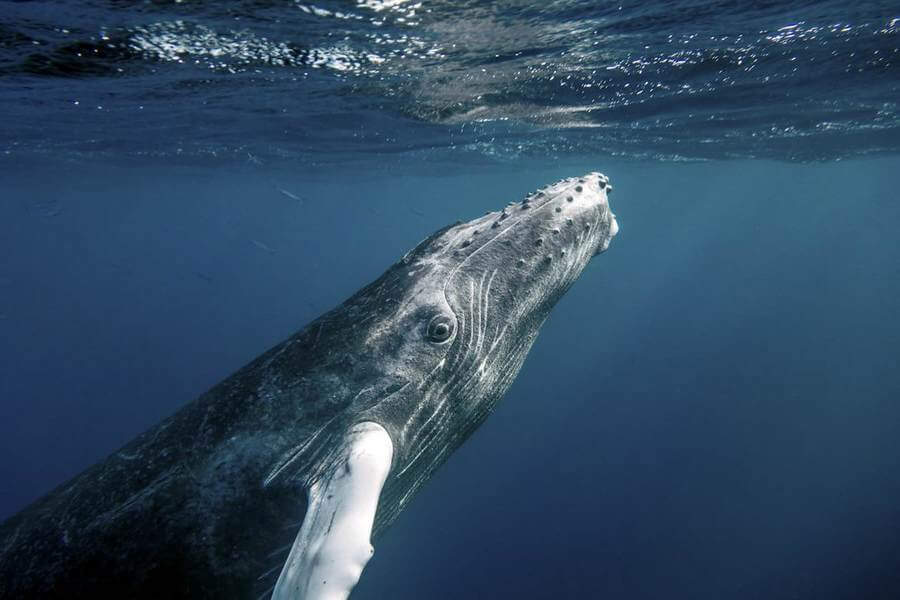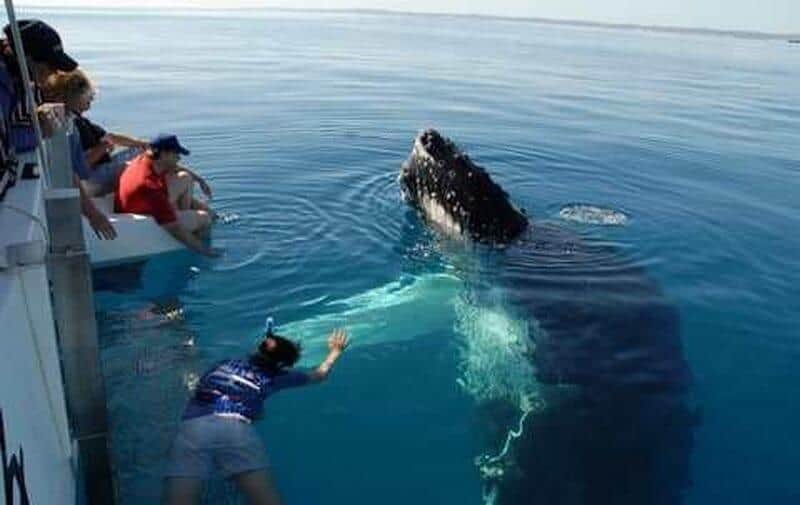How Long Can Humpback Whales Hold Their Breath
Humpback whales are one of the grandest creatures in the body of water. These incredible creatures might live in the bounding main, yet, they are considered mammals just like dolphins.
Since they are mammals, they do not accept gills like other marine life which makes their breathing a little trickier.
From their massive size (up to 16m or 52ft in length and over 30 tons or 33 short tons), playful natures, and interesting way of breathing, humpbacks are truly fascinating!
While their size is surely one of the most interesting things well-nigh them, their animate is also a compelling matter to examine.
Like dolphins, they don't accept gills. Instead, both whales and dolphins alike have blowholes that are on the top of their heads.
The presence of this blowhole really gives insight into how humpbacks are able to breathe while all the same lingering within the waters. Considering of their large size, humpback whales take two blowholes.
Dolphins, who are also underwater mammals, only have ane blowhole. The reasoning is pretty obvious because they are only a fraction of the size of a humpback whale.
The number of holes that a whale will have depends on the type of whale that it is. Humpback whales are a baleen whale type.
This means that they have plates in their oral fissure, rather than teeth, that are used for swallowing their food whole.
Humpbacks are known for eating plankton nearly of the fourth dimension, but they can eat larger fish. All baleen species of whales volition have ii blowholes.
The other type of whale classification is toothed whales. As the name implies, these whales have bodily teeth.
While they chew up their food unlike the baleen whales, they only have one blowhole very similar to dolphins.
Do Humpback Whales Exhale Air?
Humpback whales are mammals and must breathe air to survive. This is why they have blowholes atop their caput. These blowholes play a very disquisitional function in ensuring that the whale gets enough air.
Humpback whales must surface every so oft to become air in their blowholes. Just how exactly does a blowhole operate? When the humpback requires air, they simply stick their heads just above the surface.
At this indicate, their blowholes retract to take in as much air as needed. From there, the air is transported to their lungs.
These blowholes are truly a fascinating role of their anatomy. It allows them to pretty much stay submerged under the water while still getting the air they demand to exhale.
Oftentimes, these blowholes can exist referred to as their "nostrils" which while it sounds funny, is a pretty accurate description!

Tin Humpback Whales Breathe Underwater?
Every bit expressed before, humpbacks are not able to directly exhale under the water. They are considered mammals. The reason they are labelled every bit mammals lies within their need for air since they have lungs.
under the water. They are considered mammals. The reason they are labelled every bit mammals lies within their need for air since they have lungs.
They too give live birth to their young, have a tiny amount of fur about their bodies, and are able to produce milk for their offspring.
Considering that they are an ocean-dwelling species, this can be a bit hard to envision.
Still, information technology is one of many reasons that humpbacks (and other whales) are alluring to study. However, even though they cannot breathe freely under the water, they can hold their breath under the h2o.
Holding their breath under the water is really of import because they are however mammals residing within the depths of the ocean.
Nonetheless, this isn't to say that they need to be under the water for an extended flow of time. They hold their breath under the water for a couple of reasons.
The first being that they are creatures of the water even if they do have lungs and are technically mammals. The second reasoning is because of why they swoop deeper into the ocean.
The just reason that humpback whales dive deep into the bounding main is to collect succulent food. Deeper body of water areas provide a variety of foods for them to snack on.
So in reality, they just demand to be able to dive deep to hunt for specific foods.
How Long Tin A Humpback Whale Agree Its Breath Underwater?
Humpback whales take been known to hold their breath underwater for up to an 60 minutes and as fiddling as 10 minutes.
underwater for up to an 60 minutes and as fiddling as 10 minutes.
Generally speaking though, they will hold their breaths underwater for effectually 45 minutes at a time. At that betoken, they must resurface for more air intake through their blowholes.
Even still, that is a really long time to concur one'south jiff!
Considering that they live in the water merely even so need air to breathe, their internal anatomy is quite remarkable.
Their respiratory systems are quite strong giving them the ability to breathe equally needed and even hold their jiff for longer periods of time.
With the need for air, people ofttimes question how humpbacks, or whales in general, slumber.
Perhaps how they sleep is even more intriguing than their animate or size! Some scientists believe that humpback whales are able to control parts of their brains while they are sleeping.
Since they have to remember to breathe (or go up for air), information technology is suggested that they partially sleep and notwithstanding periodically become to the surface for air. Moreover, these creatures do non slumber for long periods of time.
In fact, they are just known to sleep in increments of around 30 minutes. This could be directly related to their need for air supply but it is quite for certain.
Humpback Whale Breathing Wheel
Due to their blowholes and unique mode of breathing, humpbacks take what is chosen a "animate cycle".
This breathing cycle is a part of their everyday routine and is critical for keeping them healthy and maintaining their lives nether the water.
Information technology might seem tedious for them to continually repeat their breathing cycle , however, they aren't bothered past it.
, however, they aren't bothered past it.
It is an instinct for them and just a part of their lives. So what exactly is their "animate cycle"?
A humpback's animate bike starts with them being able to spurt out of their blowholes most ii times per minute while at residue.
From this bespeak, they can increase that time frame to upwardly to 8 times per minute when they dive deeper into the water.
They come up for air about every 6 minutes and each fourth dimension they do so, they intake more air into their lungs.
With this process, they tin can store air in their lungs to help with belongings their breaths under the water for long periods of time.
This breathing cycle also allows for them to release a double stream of h2o spray through their blowholes. This stream is said to reach upwards of 13ft (or 3 metres) in the air!
For places in the world where whale watching tours occur, this is quite the sight to behold! Humpback whales are actually popular in places in Australia when the whales are on their migration journeys.
The tropical waters here are idyllic for them to relax and play. Those who venture on these whale watching tours get a unique opportunity to see these curious creatures and their breathing habits!
How Big Are A Humpback Whale's Lungs?
While humpback whales are one of the largest whales in the earth, their lungs aren't as big as one would retrieve.
aren't as big as one would retrieve.
Instead, the existent secret to their prolonged dives and ability to hold their jiff between 45 to sixty minutes lies inside their power to shop oxygen within their circulatory organisation.
While their lungs aren't that big, their respiratory and circulatory systems are! Humpback whales tin can store up to 75% of oxygen in their circulatory systems! This massive percentage means that their lungs can function quite impressively.
This storage of oxygen is another reason behind their ability to swoop deep for long periods of time. Since their circulatory systems are straight related to their lung part, the backlog oxygen on long dives is disquisitional.
Deep diving isn't safe for mammals with lungs, every bit decompression can happen where gases in the depths of the body of water can create serious problems.

This is the primary reason behind their lungs being smaller than one would think, combined with their ability to have around 75% oxygen surging through their systems.
These magnificent creatures are said to dive downwardly about 200m (or 656ft) at whatsoever given time.
While this seems quite significant, and it is, they aren't hanging out at these depths for besides long. Mostly, their deeper dives will merely last effectually xv minutes.
This is even considering that they can hold their breath for longer periods of time. Simply put, they don't have a direct need for staying submerged for too long of a time menstruation.
Well-nigh of the fourth dimension, humpbacks (and other whales) volition spend more than time closer to the surface of the water so that they can regenerate their air as needed.
Moreover, they can be seen lounging along the surface of the water equally well. As expressed before, they but need to expose the tops of their head to allow their blowholes to release and assemble air.
They are known to linger about with their heads poking upward from the surface. This gives them a truly relaxing surround with abiding admission to getting the important air that they need to maintain their lives nether the water.
Humpback whales are one of the ocean'southward many alluring creatures. From their size to their breathing and everything in between, they are truly remarkable!
- Starting time
- PREVIOUS
- Adjacent
Resource Links To Products We Use And Recommend
Source: https://www.discoverherveybay.com/humpback-whales-breathing/
0 Response to "How Long Can Humpback Whales Hold Their Breath"
Postar um comentário